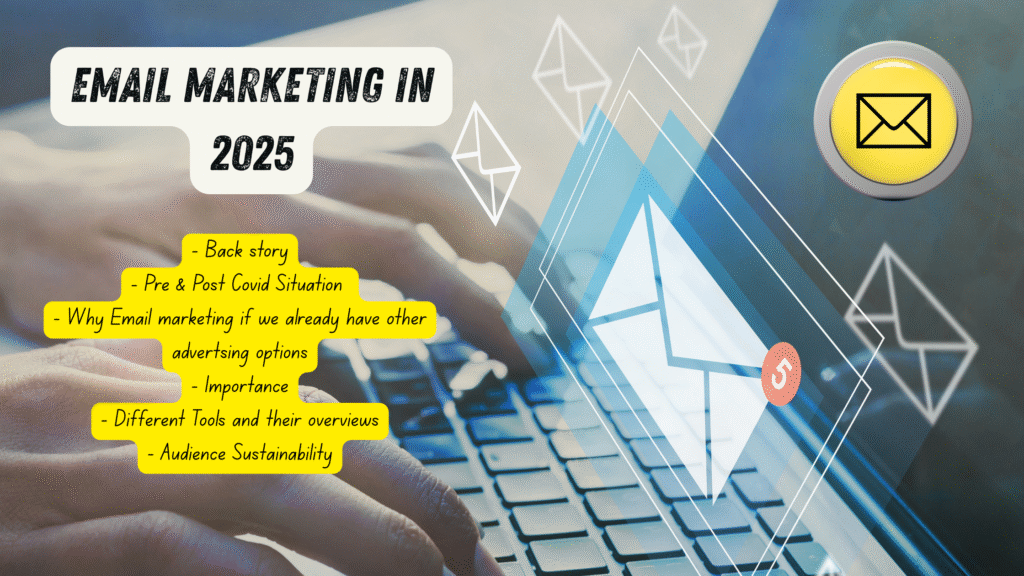Introduction to Email Marketing in 2025
Email Marketing has become a buzz word these days!! Especially after digital took over the physical forms after Pandemic COVID19. Before even diving deeper into the topic, let’s try to answer some of the questions related to this phrase.
Is it that this marketing is really needed these days? How was it in the pre-Covid era was different from now?
Other top listed questions in google – how to do email marketing? what does it do? Why is it important? Why is it important for business? Top tools? Top Platforms? How to build an email list effectively? How to segment an email list? What is double opt-in and why is it important? and this list is very huge getting deeper into this concept.. as this post is a meta about this marketing, let’s stick and try to answer these queries.
Let’s address these in below sections
– Businesses & marketing Pre-covid Vs Post-Covid!
– Emerging of this model!
– Why Email marketing?
– Top tools & Platforms?
– Audience sustainability
Businesses & marketing Pre-covid Vs Post-Covid! Emerging of the model!
Even before Covid, this marketing tool was very much existing. The only and main difference was that it was underused for many industries. There are less influencers comparatively, and it’s mainly used by companies (majorly). Even the campaign were very occasional (might be once a month!), majorly aligned with seasonal promotions or new product launches.
Small businesses had more of physical connections and marketing was much easier and straightforward with no need or room for email marketing.
As covid-19 hit in early 2020, the situations flipped overnight! Streets went silent, store shutters rolled down, and billboards started staring blankly into empty roads. The in-person touch points such as store visits, events, trade shows, and even casual coffee catch-ups disappeared almost instantly.
Brands faced a simple but brutal reality leaving with the only connection to customers now lived on their screens.
This has bumped up the need of Digital presence due to the fear of becoming non-existent or bankruptcy. This was the case for all types of business starting from Nano to Mega ones. The COVID didn’t have any form of partiality in conquering the minds of the business owners with fears.
But…but… as the success path always comes after many struggles, failed attempts, innovations, people started to look for many other ways to stay connected with each other and so the business owners to stay visible with marketing!!
People discovered that Social media has become one huge and easy way of staying connected and be communicative. This has provided an immense opportunities even for layman to outreach and portrait the skills to turn into business men/women. Many became business owners by choosing social media itself as a product/platform. Many became celebrities through video media such as Youtube, TikTok, Instagram and so on. Things changed.. Everything became digital… Starting from education to business to payments..
It has given oxygen to many business owners, with opportunities such as Facebook & Youtube Ads, social branding with influencers.. but not for a very long time.. as the number of opportunities increase, the prices too hikes it that way to avail those opportunities.. Ad costs have spiked and even the quantity of the Ads..
Hence, standing out from the crowd has become very difficult and then the need of personal communication & marketing has become very essential. In this chaotic landscape of digital world, owners started facing challenges in building genuine, long-lasting connections with their audiences. This provoked many to look for other options again apart from social media.
And hence the need and uplift of email marketing started emerging! It’s just not another tool, but a perfect bridge to make the connections on a personal level by landing directly to customer’s inboxes.
Why Email-Marketing – The perfect Solution
Email marketing is a strategic way to engage, nurture, and convert your audience like never before. And even today in 2025 and further in future, it remains as a powerhouse in the digital marketing space. Here are some main reasons for staying live for a long period of time regardless of other means of communication.

- Direct Communication with the customer: The Emails would deliver the message straight to the customer without interference from social media algorithms. There’s always a personal touch to it when it lands 1-1.
- Personalisation at Scale: Email are not just broadcasts to n number of customer, today we have many advanced tools that allow to tailor campaigns to individual customer preferences, increasing engagement rates.
- Cost Efficiency: When compared to other advertising methods, email marketing offers one of the highest returns on investment.
- Automation stays live: With automated workflows, we can send the right message at the right time effortlessly.
- Data-Driven Insights: Email platforms now provide robust analytics, helping businesses refine their strategies and achieve better results.
Today, by 2025, email marketing is no longer just a supplementary strategy— it’s become the backbone of customer communication, which is primary for driving revenue and building trust relationships. Whether it’s a small business, an enterprise, or even an e-commerce store, ignoring email marketing is a missed opportunity to grow.
Top Email Marketing Tools Overview
To succeed in email marketing, there’s always a need of right tools to bring our strategy to life. In 2025, several platforms lead the pack, offering unique features to cater to different needs. Here are some of the top email marketing tools available by 2025:
1. Mailchimp
Mailchimp is one of the oldest and most recognizable names in email marketing. It offers drag-and-drop email builders, basic automation, and pre-built templates suitable for beginners. Over time, it has expanded into offering landing pages, ads, and even basic CRM functionality. While it’s user-friendly, advanced marketers sometimes find its automation features limited compared to niche players. Post-COVID, many small businesses leaned on Mailchimp for quick setup and affordable starter plans.
Key Features: Drag-and-drop builder, pre-designed templates, landing pages, basic automation, and analytics.
Standout Quality: One of the easiest all-in-one solutions to get started with, especially for non-technical users.
Audience Suitability: Ideal for small businesses, solopreneurs, and startups looking for an affordable, beginner-friendly platform.
2. Constant Contact
Constant Contact is a long-standing player with strong support for small businesses and nonprofits. It’s known for its simplicity, customer support, and event management features. The platform includes hundreds of templates, an intuitive editor, and built-in analytics to track engagement. It isn’t as advanced in automation or integrations as some newer tools, but it remains a go-to for organizations that value hand-holding. Many brick-and-mortar businesses that went digital during COVID turned to Constant Contact for accessible outreach.
Key Features: Large template library, event management, social media integrations, and reliable customer support.
Standout Quality: Simplified email creation plus event promotion features make it popular with community-focused brands.
Audience Suitability: Best for nonprofits, local businesses, and community organizations that want straightforward email outreach without heavy automation.
3. ActiveCampaign
ActiveCampaign focuses heavily on marketing automation and customer journeys. Its strength lies in advanced segmentation, behavioral tracking, and CRM integration. Unlike simpler platforms, it allows businesses to create sophisticated, multi-step automations triggered by customer actions. It also includes sales automation features, making it popular for businesses with longer pipelines. Post-COVID, it became a favorite for e-commerce and service businesses that needed smart, automated engagement.
Key Features: Advanced automation workflows, CRM integration, behavioral tracking, and deep segmentation.
Standout Quality: Powerful marketing automation engine that allows creating complex customer journeys.
Audience Suitability: Perfect for mid-sized businesses, SaaS startups, and e-commerce stores that rely on sophisticated lifecycle campaigns.
4. HubSpot Email Marketing
HubSpot integrates email marketing with its powerful CRM, creating a seamless inbound marketing ecosystem. It allows for highly personalized campaigns, using customer behavior and lifecycle stage data. The tool also provides detailed analytics and A/B testing for optimization. Though expensive compared to standalone email tools, its strength is in unifying sales, marketing, and service. Many companies adopted HubSpot post-COVID to consolidate digital customer relationships into one platform.
Key Features: CRM integration, personalization, analytics, and A/B testing as part of a larger inbound marketing suite.
Standout Quality: Complete alignment of email with CRM data, giving a 360° view of customer interactions.
Audience Suitability: Best suited for growing businesses and enterprises that need unified CRM + sales + marketing automation in one place.
5. Sendinblue (Brevo)
Sendinblue, rebranded as Brevo, gained popularity for offering both email and SMS marketing in one platform. Its automation features are strong, with options for transactional emails, workflows, and audience segmentation. Pricing is based on email volume, which is more flexible for small businesses than per-contact models. It also has a simple drag-and-drop editor and integrations with e-commerce platforms. During COVID, many small to mid-sized businesses leaned on Brevo for affordability and multi-channel messaging.
Key Features: Email campaigns, transactional emails, SMS marketing, automation workflows, and pay-as-you-go pricing.
Standout Quality: Combines email + SMS marketing under one affordable plan, unlike most competitors.
Audience Suitability: Great for e-commerce businesses, cost-conscious startups, and SMBs that want multi-channel engagement at flexible pricing.
6. Flodesk
Flodesk is a newer, design-focused email platform popular with creators and small business owners. It stands out with its stunning, modern templates that look great on both desktop and mobile. Unlike most platforms, Flodesk offers flat-rate pricing — unlimited emails and subscribers for one price. However, it lacks some advanced automation features compared to tools like ActiveCampaign. Post-COVID, it became especially popular among solopreneurs, course creators, and Etsy sellers who valued branding aesthetics.
Key Features: Beautifully designed templates, unlimited subscribers/emails at flat pricing, and simple automation flows.
Standout Quality: Aesthetically stunning emails with a flat-rate pricing model, making it attractive to creatives.
Audience Suitability: Perfect for creatives, influencers, Etsy sellers, and solopreneurs who value design and branding consistency over complex automation.
7. ConvertKit
ConvertKit is built specifically for creators — bloggers, YouTubers, podcasters, and online educators. Its strength is in creating subscriber funnels, offering email courses, and tagging users based on interests. The tool integrates well with digital selling platforms like Gumroad, Shopify, and Teachable. It provides automation that balances power with simplicity, making it easy for creators to nurture audiences without overwhelm. After COVID accelerated the creator economy, ConvertKit became a go-to tool for building direct fan relationships.
Key Features: Email courses, subscriber tagging, automation funnels, and integrations with platforms like Gumroad & Teachable.
Standout Quality: Creator-first tool that makes it easy to build and monetize audiences.
Audience Suitability: Tailored for content creators, educators, bloggers, and online entrepreneurs selling knowledge products or memberships.
Each tool brings its own strengths, making it essential to match the platform to your specific goals and audience type.
Audience Suitability for Email Marketing Tools
Email marketing tools are not one-size-fits-all. Each platform is designed to cater to specific business needs and audience types. Here’s a guide to selecting the right tool based on your audience:
Small Businesses
Mailchimp and Constant Contact are excellent choices. They’re affordable, beginner-friendly, and provide the essential features needed to build lists, send newsletters, and track engagement without overwhelming complexity.
E-Commerce Stores
ActiveCampaign and Sendinblue (Brevo) are great fits here. ActiveCampaign offers advanced automation and behavioral targeting that boost repeat purchases, while Sendinblue combines email + SMS marketing, which is ideal for driving real-time sales and promotions.
Enterprises
HubSpot stands out for enterprises and fast-scaling companies. Its all-in-one ecosystem integrates email, CRM, analytics, lead management, and automation, making it perfect for larger teams managing complex workflows across departments.
Nonprofits & Community Organizations
Constant Contact shines for nonprofits with its event management tools, donation campaigns, and social media integrations. Its simplicity helps smaller teams run effective campaigns without needing deep technical expertise.
Creators & Influencers
Flodesk and ConvertKit are tailored for creators, influencers, and educators. Flodesk focuses on visually stunning email designs with flat-rate pricing, while ConvertKit provides automation funnels, tagging, and direct integrations with creator platforms like Gumroad and Teachable.
Marketers Needing CRM Integration
ActiveCampaign is the go-to for businesses that want marketing and sales to work seamlessly together. Its lead scoring, advanced segmentation, and pipeline management give marketers a deep understanding of customer journeys.
Understanding your audience’s unique requirements is critical to choosing the right tool, ensuring maximum impact and efficiency.
Conclusion and Key Takeaways
Email marketing is more than relevant in 2025—it’s essential. It cuts through the noise, delivers unmatched ROI, and builds strong customer relationships in ways that social media or ads alone cannot do. From small businesses to large enterprises, every organization can benefit from targeted, cost-effective, and personalized communication that email marketing offers.
With tools like these, there’s no shortage of options to power the campaigns. Each platform brings unique strengths — whether it’s a beginner-friendly ease of use, advanced automation and CRM integration, stunning design templates, or creator-focused audience building
The key takeaway? Choose a platform that aligns with your audience and business needs. The right tool will help you connect more effectively, drive engagement, and achieve your goals in today’s competitive digital landscape. In 2025, your success is truly just one email away.
In a post-COVID world, the inbox has become the new storefront—make sure yours is always open.
After you choose a tool, you might want to go through some tips for email marketing to consider while using them. The post from litmus.com has a effective post that helps.
Here is another post that I liked a lot which is very simple and sweet from emailoctopus.
Now with this knowledge that I had acquired been shared here, taking a leave for now. Further, I shall come up with separate posts for these tools as a review as possible. Also other posts about hard-bounce, Opt-ins, email-lists, shall try to cover in another post.
Until then, happy Email Marketing!
For other articles on freelancing tools, click here.
For workflows and strategies click here.

